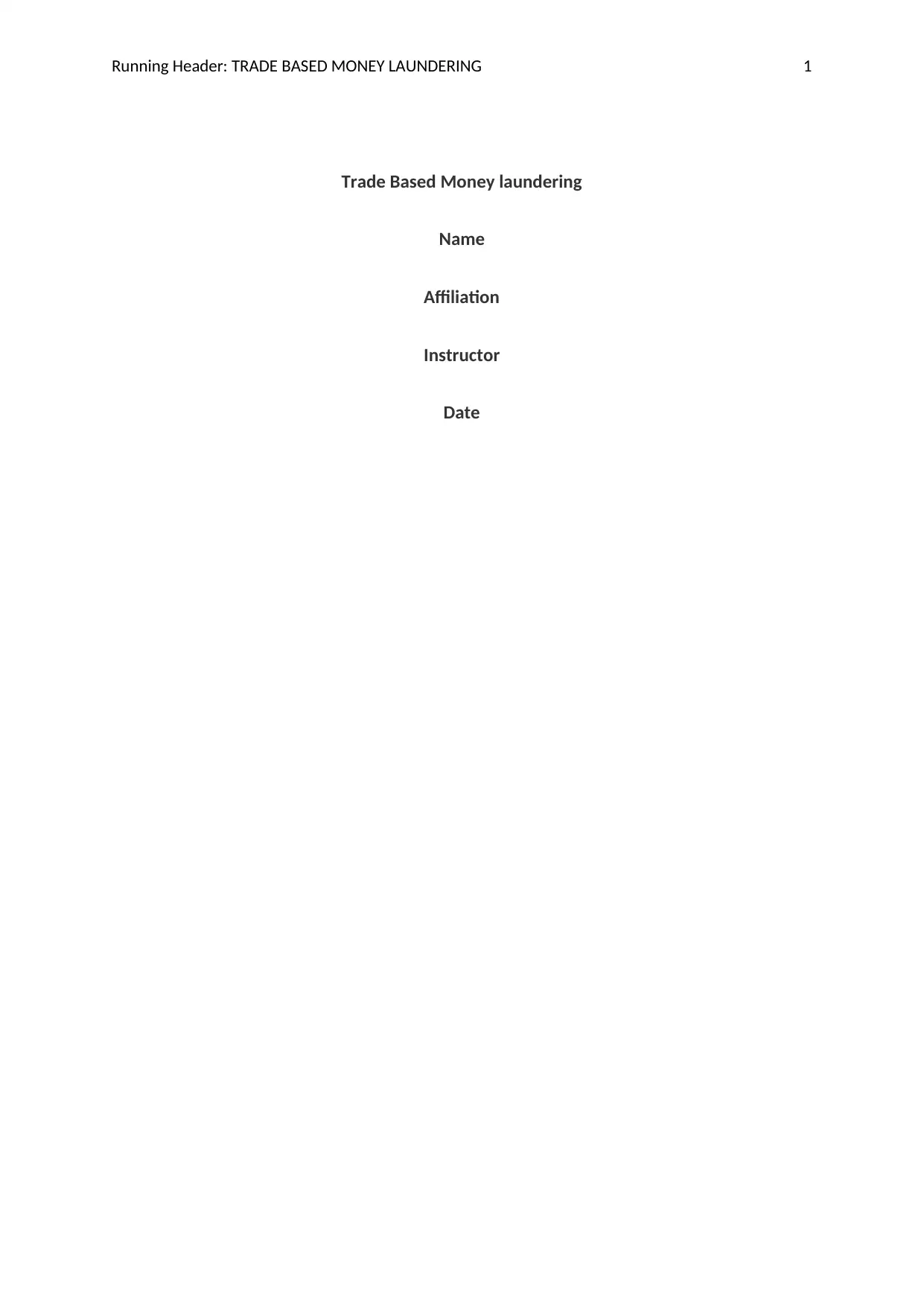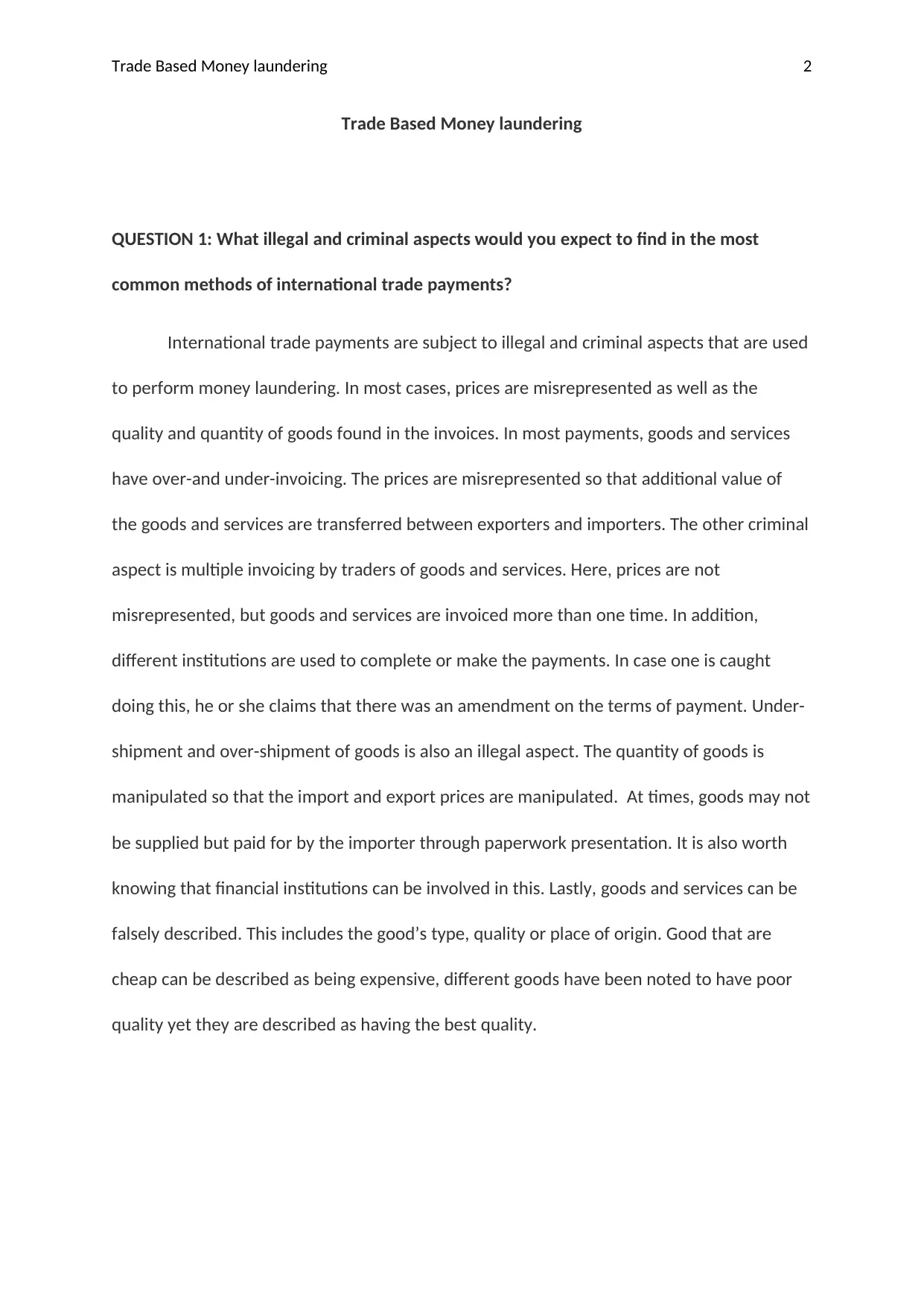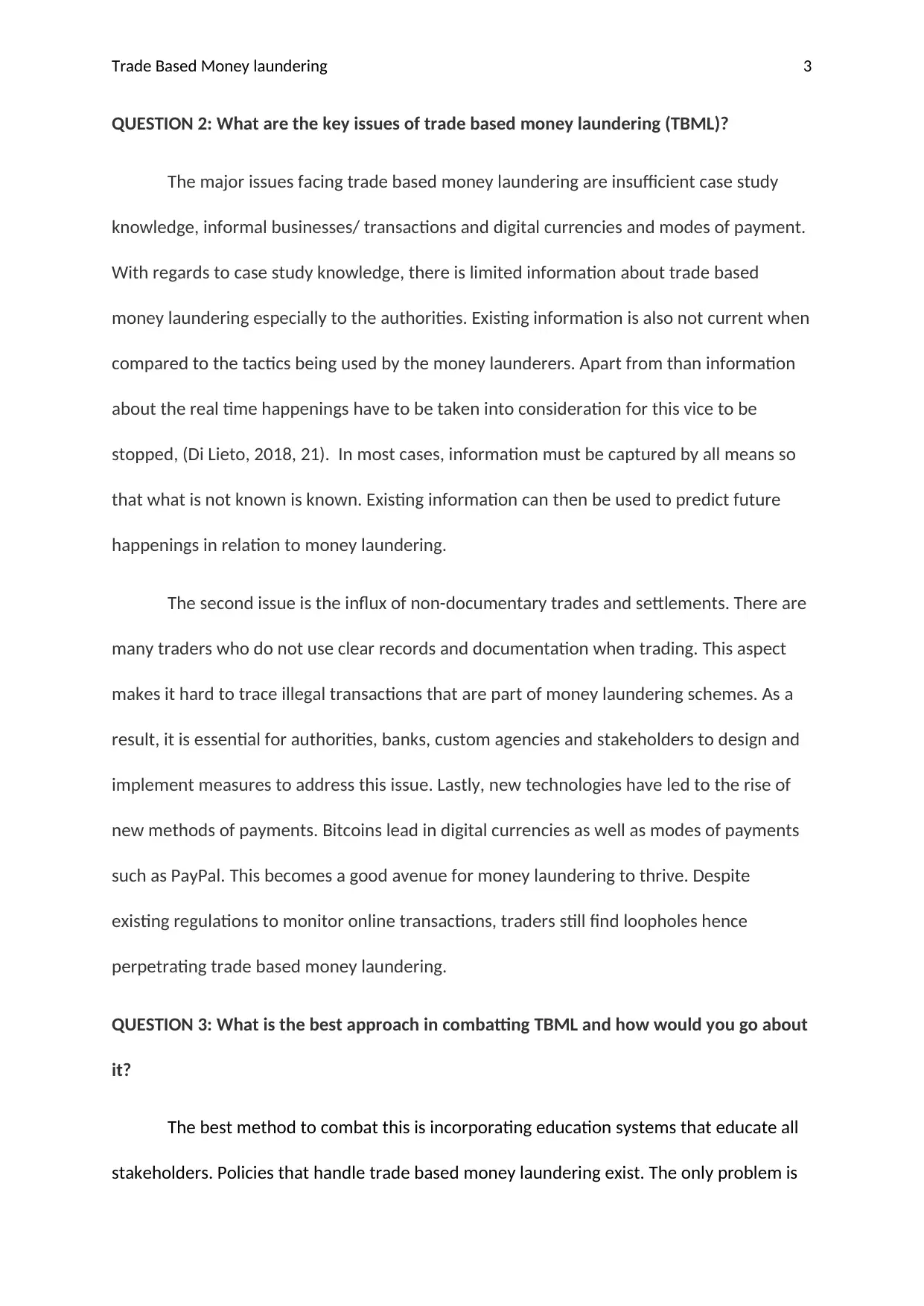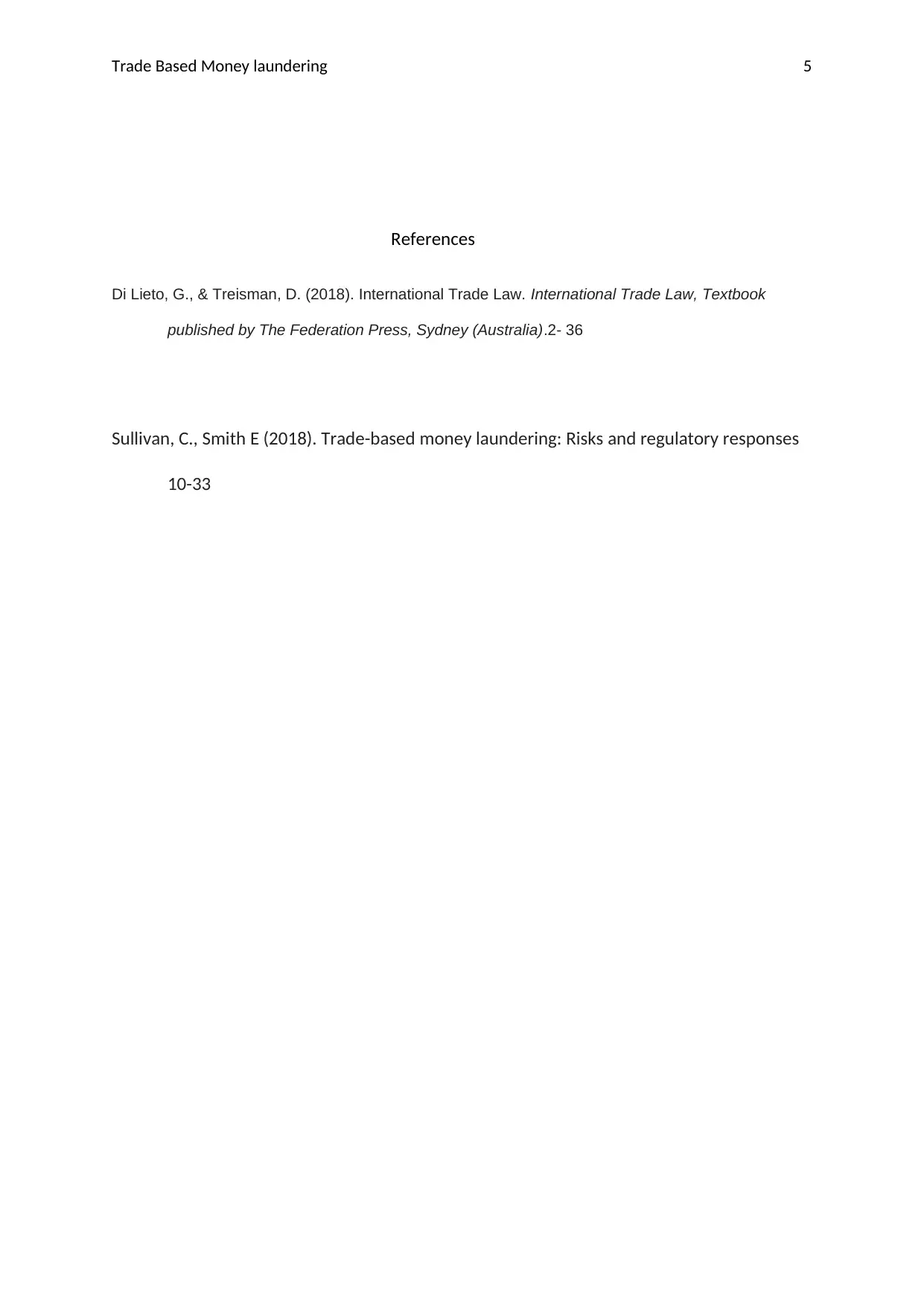Trade Based Money Laundering: Methods, Issues, and Solutions
VerifiedAdded on 2023/04/25
|5
|964
|292
Report
AI Summary
This report delves into the critical aspects of trade-based money laundering (TBML), examining the illegal and criminal activities prevalent in international trade payments. It identifies methods such as misrepresentation of prices, multiple invoicing, under/over-shipment, and false descriptions of goods. The report highlights key issues, including limited case study knowledge, the rise of informal transactions, and the impact of digital currencies. It proposes that effective combatting strategies involve comprehensive education for all stakeholders, including banks, customs agencies, and law enforcement. The report emphasizes the need for inter-agency cooperation and strict adherence to laws and regulations to successfully prevent and prosecute TBML activities. The study underscores the importance of understanding transaction cycles and adapting to new technologies to effectively address this evolving financial crime.

Running Header: TRADE BASED MONEY LAUNDERING 1
Trade Based Money laundering
Name
Affiliation
Instructor
Date
Trade Based Money laundering
Name
Affiliation
Instructor
Date
Paraphrase This Document
Need a fresh take? Get an instant paraphrase of this document with our AI Paraphraser

Trade Based Money laundering 2
Trade Based Money laundering
QUESTION 1: What illegal and criminal aspects would you expect to find in the most
common methods of international trade payments?
International trade payments are subject to illegal and criminal aspects that are used
to perform money laundering. In most cases, prices are misrepresented as well as the
quality and quantity of goods found in the invoices. In most payments, goods and services
have over-and under-invoicing. The prices are misrepresented so that additional value of
the goods and services are transferred between exporters and importers. The other criminal
aspect is multiple invoicing by traders of goods and services. Here, prices are not
misrepresented, but goods and services are invoiced more than one time. In addition,
different institutions are used to complete or make the payments. In case one is caught
doing this, he or she claims that there was an amendment on the terms of payment. Under-
shipment and over-shipment of goods is also an illegal aspect. The quantity of goods is
manipulated so that the import and export prices are manipulated. At times, goods may not
be supplied but paid for by the importer through paperwork presentation. It is also worth
knowing that financial institutions can be involved in this. Lastly, goods and services can be
falsely described. This includes the good’s type, quality or place of origin. Good that are
cheap can be described as being expensive, different goods have been noted to have poor
quality yet they are described as having the best quality.
Trade Based Money laundering
QUESTION 1: What illegal and criminal aspects would you expect to find in the most
common methods of international trade payments?
International trade payments are subject to illegal and criminal aspects that are used
to perform money laundering. In most cases, prices are misrepresented as well as the
quality and quantity of goods found in the invoices. In most payments, goods and services
have over-and under-invoicing. The prices are misrepresented so that additional value of
the goods and services are transferred between exporters and importers. The other criminal
aspect is multiple invoicing by traders of goods and services. Here, prices are not
misrepresented, but goods and services are invoiced more than one time. In addition,
different institutions are used to complete or make the payments. In case one is caught
doing this, he or she claims that there was an amendment on the terms of payment. Under-
shipment and over-shipment of goods is also an illegal aspect. The quantity of goods is
manipulated so that the import and export prices are manipulated. At times, goods may not
be supplied but paid for by the importer through paperwork presentation. It is also worth
knowing that financial institutions can be involved in this. Lastly, goods and services can be
falsely described. This includes the good’s type, quality or place of origin. Good that are
cheap can be described as being expensive, different goods have been noted to have poor
quality yet they are described as having the best quality.

Trade Based Money laundering 3
QUESTION 2: What are the key issues of trade based money laundering (TBML)?
The major issues facing trade based money laundering are insufficient case study
knowledge, informal businesses/ transactions and digital currencies and modes of payment.
With regards to case study knowledge, there is limited information about trade based
money laundering especially to the authorities. Existing information is also not current when
compared to the tactics being used by the money launderers. Apart from than information
about the real time happenings have to be taken into consideration for this vice to be
stopped, (Di Lieto, 2018, 21). In most cases, information must be captured by all means so
that what is not known is known. Existing information can then be used to predict future
happenings in relation to money laundering.
The second issue is the influx of non-documentary trades and settlements. There are
many traders who do not use clear records and documentation when trading. This aspect
makes it hard to trace illegal transactions that are part of money laundering schemes. As a
result, it is essential for authorities, banks, custom agencies and stakeholders to design and
implement measures to address this issue. Lastly, new technologies have led to the rise of
new methods of payments. Bitcoins lead in digital currencies as well as modes of payments
such as PayPal. This becomes a good avenue for money laundering to thrive. Despite
existing regulations to monitor online transactions, traders still find loopholes hence
perpetrating trade based money laundering.
QUESTION 3: What is the best approach in combatting TBML and how would you go about
it?
The best method to combat this is incorporating education systems that educate all
stakeholders. Policies that handle trade based money laundering exist. The only problem is
QUESTION 2: What are the key issues of trade based money laundering (TBML)?
The major issues facing trade based money laundering are insufficient case study
knowledge, informal businesses/ transactions and digital currencies and modes of payment.
With regards to case study knowledge, there is limited information about trade based
money laundering especially to the authorities. Existing information is also not current when
compared to the tactics being used by the money launderers. Apart from than information
about the real time happenings have to be taken into consideration for this vice to be
stopped, (Di Lieto, 2018, 21). In most cases, information must be captured by all means so
that what is not known is known. Existing information can then be used to predict future
happenings in relation to money laundering.
The second issue is the influx of non-documentary trades and settlements. There are
many traders who do not use clear records and documentation when trading. This aspect
makes it hard to trace illegal transactions that are part of money laundering schemes. As a
result, it is essential for authorities, banks, custom agencies and stakeholders to design and
implement measures to address this issue. Lastly, new technologies have led to the rise of
new methods of payments. Bitcoins lead in digital currencies as well as modes of payments
such as PayPal. This becomes a good avenue for money laundering to thrive. Despite
existing regulations to monitor online transactions, traders still find loopholes hence
perpetrating trade based money laundering.
QUESTION 3: What is the best approach in combatting TBML and how would you go about
it?
The best method to combat this is incorporating education systems that educate all
stakeholders. Policies that handle trade based money laundering exist. The only problem is
⊘ This is a preview!⊘
Do you want full access?
Subscribe today to unlock all pages.

Trusted by 1+ million students worldwide

Trade Based Money laundering 4
lack of knowledge on how to implement them successfully. It is necessary for stakeholders
such as banking institutions, custom agencies, as well as shipping agencies and the law
enforcers to come together and institute measures against those aiding and abetting money
laundering. Through education, these shareholders are able to understand the various
avenues for the crime, how it is done, when and the perpetrators. The transaction cycles
have to be understood too because there are many gaps that are used to beat the systems.
For this to be stopped, the private sector and the public sector has to be enjoined so that
these loopholes are sealed, (Sullivan, 2018, 22). Education should also comprise new
technologies that are used to promote the vice. Existing bank employees, law enforcers
should be taught about payment methods such as PayPal and the use of cryptocurrencies.
On the other hand, inter-agency cooperation must be promoted. This helps in keeping check
and balances as well as educating other agencies about the factors they do not know. For
example, bankers can educate law enforcers on how to read and interpret transaction
documents presented to them. This will lead to the ultimate stopping of money laundering.
In as much as government agencies and traders try to extinguish this vice, the only factor
that will lead to its success is implementation of strategies and strict adherence to laws and
regulations when apprehending and charging the culprits for trade based money laundering
activities.
lack of knowledge on how to implement them successfully. It is necessary for stakeholders
such as banking institutions, custom agencies, as well as shipping agencies and the law
enforcers to come together and institute measures against those aiding and abetting money
laundering. Through education, these shareholders are able to understand the various
avenues for the crime, how it is done, when and the perpetrators. The transaction cycles
have to be understood too because there are many gaps that are used to beat the systems.
For this to be stopped, the private sector and the public sector has to be enjoined so that
these loopholes are sealed, (Sullivan, 2018, 22). Education should also comprise new
technologies that are used to promote the vice. Existing bank employees, law enforcers
should be taught about payment methods such as PayPal and the use of cryptocurrencies.
On the other hand, inter-agency cooperation must be promoted. This helps in keeping check
and balances as well as educating other agencies about the factors they do not know. For
example, bankers can educate law enforcers on how to read and interpret transaction
documents presented to them. This will lead to the ultimate stopping of money laundering.
In as much as government agencies and traders try to extinguish this vice, the only factor
that will lead to its success is implementation of strategies and strict adherence to laws and
regulations when apprehending and charging the culprits for trade based money laundering
activities.
Paraphrase This Document
Need a fresh take? Get an instant paraphrase of this document with our AI Paraphraser

Trade Based Money laundering 5
References
Di Lieto, G., & Treisman, D. (2018). International Trade Law. International Trade Law, Textbook
published by The Federation Press, Sydney (Australia).2- 36
Sullivan, C., Smith E (2018). Trade-based money laundering: Risks and regulatory responses
10-33
References
Di Lieto, G., & Treisman, D. (2018). International Trade Law. International Trade Law, Textbook
published by The Federation Press, Sydney (Australia).2- 36
Sullivan, C., Smith E (2018). Trade-based money laundering: Risks and regulatory responses
10-33
1 out of 5
Related Documents
Your All-in-One AI-Powered Toolkit for Academic Success.
+13062052269
info@desklib.com
Available 24*7 on WhatsApp / Email
![[object Object]](/_next/static/media/star-bottom.7253800d.svg)
Unlock your academic potential
Copyright © 2020–2025 A2Z Services. All Rights Reserved. Developed and managed by ZUCOL.





